Birdwatching in Arkansas offers a wonderful opportunity to spot a variety of doves, each with unique colors, calls, and behaviors. From urban neighborhoods to open fields, these gentle birds are easy to observe and fascinating to study.
Mourning Doves, Eurasian Collared-Doves, White-winged Doves, Inca Doves, Common Ground Doves, and Rock Pigeons all make their homes across the state. Each species has distinct features that make identification simple for beginners and experienced birders alike.
Feeding them in your backyard or watching them in natural habitats allows you to appreciate their soft coos, graceful flight, and subtle beauty, making them a delight to spot year-round.
Common Doves Found in Arkansas
Mourning Dove (Zenaida macroura)
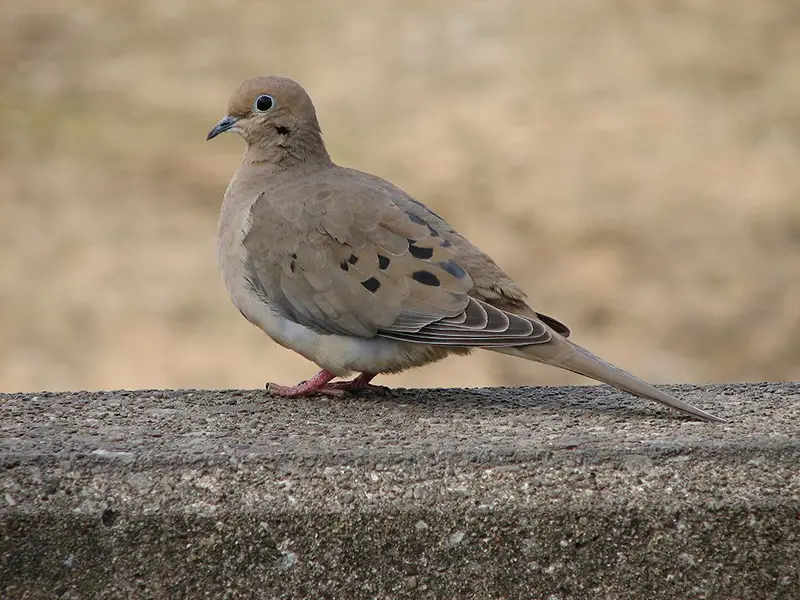
The Mourning Dove is a slender, medium-sized bird measuring about 31 cm in length, with a wingspan ranging from 37 to 45 cm. Its plumage is light gray-brown on the back and pale underneath, with black spots on the wings and a white-tipped tail. Males often have a bluish-gray crown and a subtle pinkish hue on the breast, while females are slightly duller in color. This gentle appearance, combined with its long, pointed tail, makes it easily recognizable among other doves.
Mourning Doves are diurnal and are often seen perched on utility wires or foraging on the ground in open fields, grasslands, and suburban backyards. Their flight is rapid and straight, producing soft, mournful cooing calls that are easily identifiable. These birds are highly adaptable, thriving in a variety of habitats throughout Arkansas, from rural farmlands to city parks.
Their diet consists primarily of seeds, including those from grasses, weeds, and agricultural crops. They forage mostly on the ground, walking rather than hopping, and often swallow small grit to aid digestion. Bird feeders stocked with millet, sunflower, or safflower seeds attract them easily.
Mourning Doves are prolific breeders, capable of raising up to six broods per year in warmer climates. They build simple nests in trees or shrubs, where both parents incubate the eggs and feed the hatchlings crop milk. Fledging occurs in about 11–15 days, after which the young remain dependent on their parents for a short period. A fun fact is that their name comes from the sorrowful quality of their soft cooing, which sounds like mourning.
Eurasian Collared-Dove (Streptopelia decaocto)
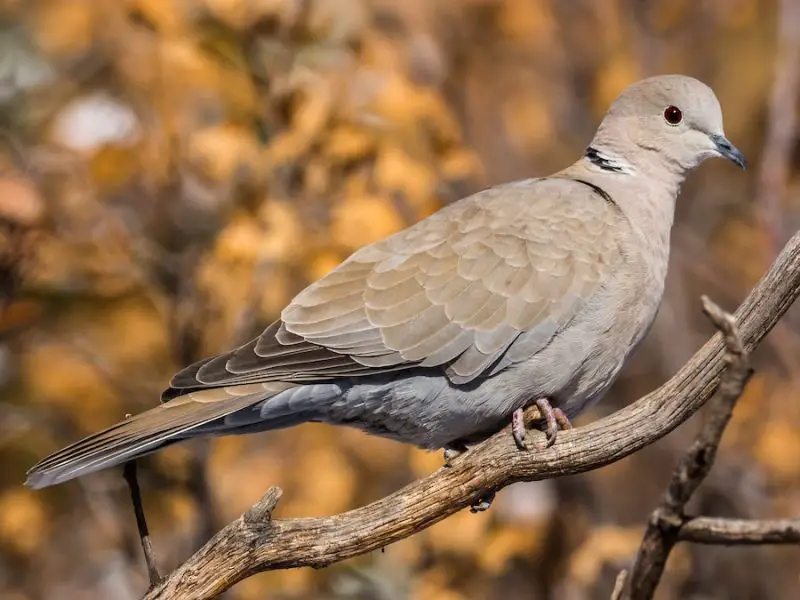
The Eurasian Collared-Dove is a medium-sized dove measuring 38 to 40 cm in length with a wingspan of 55 to 60 cm. Its pale grayish plumage is accented by a distinctive black crescent-shaped collar on the back of the neck and a long, squared tail. This species is slightly larger and more robust than the Mourning Dove, giving it a sturdy, elegant appearance. Its soft, cooing call and deliberate movements make it easily distinguishable.
Introduced to North America in the 1970s, the Eurasian Collared-Dove has rapidly spread and is now common in Arkansas. It is often seen in urban and suburban areas, perching on wires, rooftops, or foraging on the ground. Its flight is slow and steady, and its cooing call has a rhythmic quality that sets it apart from other local doves.
The diet of the Eurasian Collared-Dove consists mainly of seeds, grains, and sometimes berries. They feed on the ground but occasionally visit trees or shrubs in search of food. They are frequent visitors to bird feeders, particularly those offering millet or sunflower seeds, and are not shy around human activity.
Eurasian Collared-Doves are monogamous and often form long-term pair bonds. They build flimsy stick nests in trees or on buildings and usually lay two white eggs. Both parents take turns incubating and feeding the young. In warmer regions, they can breed year-round, which contributes to their rapid population growth. A fun fact is that their quick spread across the U.S. is one of the fastest range expansions of any bird species.
White-winged Dove (Zenaida asiatica)
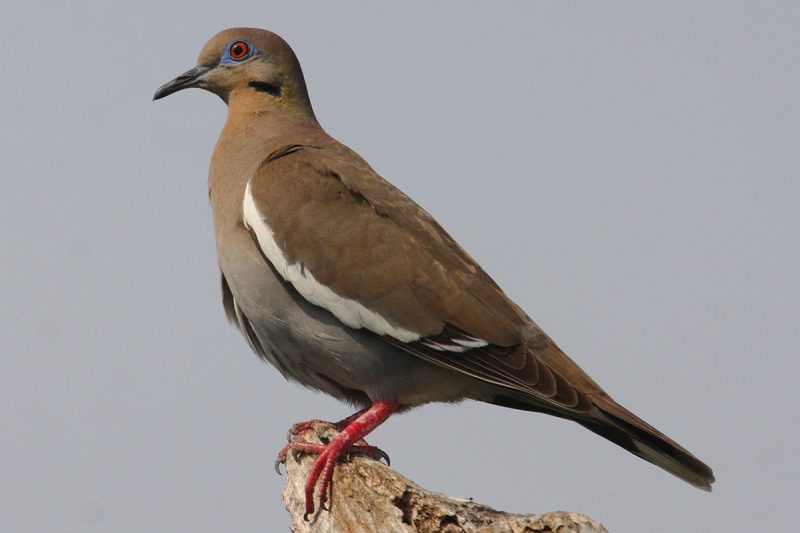
The White-winged Dove is a stout, medium-sized bird measuring about 29 cm in length with a wingspan ranging from 48 to 58 cm. Its brownish-gray body is marked by a striking white crescent on the edge of each wing, visible in flight. It has a squared tail and a relatively long, thin bill. Its plumage is simple yet elegant, making it distinguishable from other doves, particularly when in flight.
In Arkansas, the White-winged Dove is considered a rare visitor, mainly observed in the southern part of the state. It inhabits open woodlands, scrublands, farmlands, and urban areas where food is available. Its distinctive call, which sounds like a repeated “who-cooks-for-you,” is often heard before the bird is seen. Its flight is heavy and direct, giving it a purposeful appearance.
The White-winged Dove feeds mainly on seeds, including sunflower, milo, corn, and safflower, and also eats berries from trees and shrubs. In urban areas, it may take advantage of human-provided food sources. The bird forages on the ground, often walking with short steps while pecking at seeds.
White-winged Doves build simple stick nests in trees and lay two white eggs per brood. Both parents share incubation and chick-rearing duties. They are productive breeders and may nest multiple times per year when conditions are favorable. A fun fact about this species is that their white wing patches are so prominent in flight that they appear almost like flashes of light, making them easy to spot from a distance.
Inca Dove (Columbina inca)
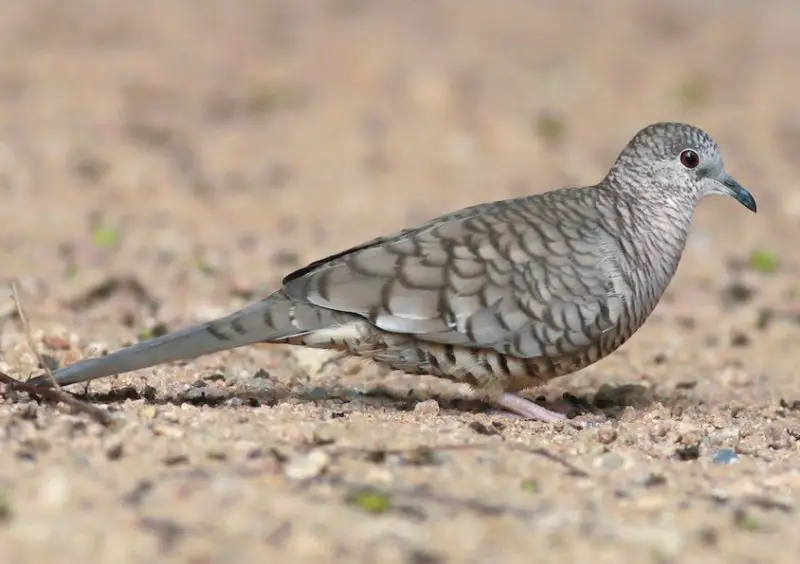
The Inca Dove is a small, slender bird, measuring around 18–20 cm in length with a wingspan of approximately 24–26 cm. Its plumage is light brown with delicate “scaled” feather patterns that give it a unique textured appearance. It has a long, square tail and a relatively small head, making it appear delicate compared to larger doves. Its subtle coloration allows it to blend easily into urban and woodland environments.
In Arkansas, the Inca Dove is uncommon but steadily expanding its range. It prefers open woodlands, urban areas, and suburban yards with bird feeders. Its flight is fast and direct, and it often flutters quickly between trees or bushes. The Inca Dove’s soft, high-pitched cooing call is less mournful than the Mourning Dove, making it a quieter presence in local habitats.
This species feeds primarily on small seeds and grains, including millet, sunflower seeds, and grasses. They forage on the ground and often in loose flocks, walking slowly as they search for food. Unlike larger doves, Inca Doves are quite agile and can dart quickly to escape predators or move between feeding areas.
Inca Doves build simple nests of twigs in shrubs or low trees, laying two white eggs per clutch. Both parents incubate and feed the chicks, which fledge in roughly two weeks. A fun fact about Inca Doves is their habit of roosting in tight, pyramid-like groups at night to conserve warmth, a behavior not commonly seen in other dove species.
Common Ground Dove (Columbina passerina)
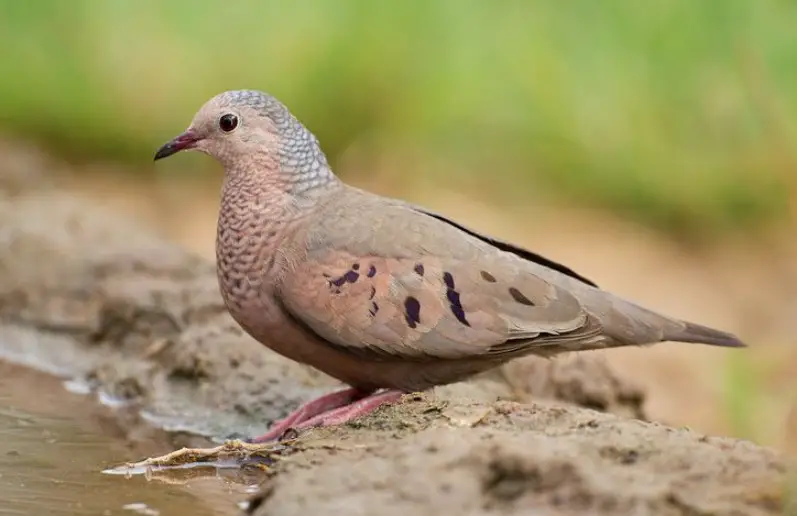
The Common Ground Dove is the smallest dove in North America, measuring only about 15–18 cm in length with a wingspan of 22–25 cm. Its plumage is dusty gray-brown with reddish-brown underwings and subtle speckling across the back. It has a short, squared tail and small head, giving it a sparrow-like appearance. Its compact size and muted colors help it remain inconspicuous in grasslands and open areas.
This species is rare in Arkansas and is most often spotted in the southern or central parts of the state. It inhabits dry, open habitats such as grasslands, scrublands, agricultural fields, and the edges of forests. Its flight is quick and low to the ground, usually accompanied by a soft cooing or clattering call. They are secretive birds, often blending into their surroundings to avoid detection.
Common Ground Doves feed mainly on seeds, picking them from the ground in open areas. They also consume small berries and occasionally forage near feeders. Their diet is supplemented by grit, which helps them grind seeds in their gizzard. These birds are active foragers, often moving in small groups while remaining alert for predators.
For reproduction, Common Ground Doves build small, simple stick nests close to the ground or in low shrubs, laying one to two white eggs per clutch. Both parents share incubation and chick-rearing duties. Young fledge in roughly two weeks. A fun fact is that despite their small size, they produce surprisingly loud cooing calls, often giving the impression of a much larger bird nearby.
Rock Pigeon (Columba livia)
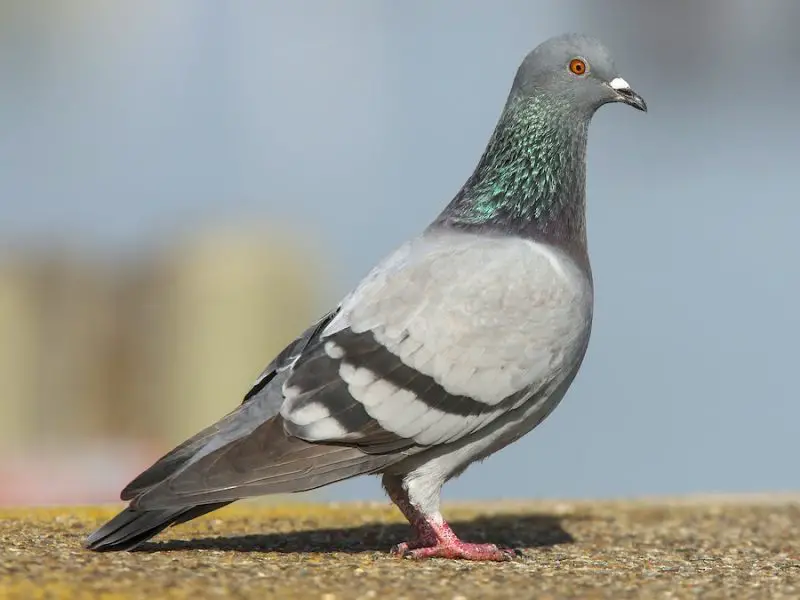
The Rock Pigeon is a robust, medium-to-large bird, measuring 32–37 cm in length with a wingspan of 64–72 cm. Its coloration is highly variable, but the most common form is bluish-gray with two dark wing bands, a pale rump, and orange-red eyes. Some individuals show white, black, or mottled color patterns. Its strong build and distinctive coloration make it unmistakable, especially in urban areas.
Rock Pigeons are extremely common throughout Arkansas, particularly in cities, towns, and agricultural regions. They thrive in areas with abundant human activity, nesting on building ledges, bridges, and other structures. Their flight is swift and direct, often in flocks, and their calls are soft cooing sounds, sometimes accompanied by occasional wing claps.
Their diet is highly opportunistic and includes seeds, grains, small fruits, and food scraps provided by humans. They forage on the ground in flocks, using their strong beaks to peck at hard seeds. Their adaptability to urban and rural habitats contributes to their wide distribution and high population density.
Rock Pigeons build simple nests on ledges, rafters, or cliff-like surfaces, laying one to two eggs per clutch. Both parents incubate and feed the chicks crop milk until they are ready to fledge. A fun fact about Rock Pigeons is that domestic pigeons and fancy breeds have been selectively bred from this species, and they have been used for centuries as messengers due to their remarkable homing ability.
Best Times and Places to See Doves in Arkansas
Doves in Arkansas can be observed throughout the year, but early mornings and late afternoons are generally the most active times for feeding and social behaviors. Mourning Doves, the most common species, are easy to spot in open fields, grasslands, farmlands, and suburban backyards, often perched on wires or fence posts. Eurasian Collared-Doves thrive in urban and suburban areas, including parks, neighborhoods, and around feeders, making city and town environments excellent locations to watch them.
White-winged Doves, though rarer in the state, are most likely to be seen in the southern regions of Arkansas. They favor open woodlands, scrublands, and areas with scattered trees or shrubs, particularly near food sources. Inca Doves prefer suburban yards, gardens, and open woodland edges, and their small size and subtle coloring make early morning observation ideal when light is soft and shadows are minimal.
Common Ground Doves, being secretive, are best spotted in dry, open habitats such as grasslands, scrublands, and agricultural edges. Observers should remain quiet and move slowly to avoid startling them. Rock Pigeons, abundant in cities and towns, are easily seen at any time of day on building ledges, bridges, parks, and urban plazas, often in large flocks where they feed and interact socially.
By targeting these specific habitats during peak activity hours, birdwatchers and photographers have the highest chance of spotting, identifying, and enjoying all six dove species in Arkansas.
FAQs About Doves in Arkansas
What types of doves can be found in Arkansas?
Arkansas is home to several dove species, including Mourning Dove, Eurasian Collared-Dove, White-winged Dove, Inca Dove, Common Ground Dove, and Rock Pigeon. Mourning Doves are the most common, while White-winged and Common Ground Doves are rarer.
When is the best time to see doves in Arkansas?
The best times are early mornings and late afternoons when doves are most active for feeding and social behaviors. These periods provide optimal lighting for observation and photography.
Where should I look for different dove species?
Open fields, farmlands, and suburban backyards are ideal for Mourning Doves. Urban and suburban areas, parks, and feeders are best for Eurasian Collared-Doves and Rock Pigeons. Southern woodlands and scrublands offer the best chance to spot White-winged Doves. Inca Doves prefer garden edges and open woodlands, while Common Ground Doves are usually found in dry grasslands and scrubby areas.
What do doves eat in Arkansas?
Most doves feed primarily on seeds, including grasses, grains, and sunflower seeds. Some species, like White-winged Doves, also eat berries. They often forage on the ground and may visit bird feeders in residential areas.
How can I attract doves to my backyard?
Providing bird feeders stocked with millet, sunflower, or safflower seeds is very effective. Open spaces for ground foraging, a nearby water source, and some shrubs or small trees for perching and nesting will make your yard more attractive to doves.
How do doves reproduce in Arkansas?
Doves typically build simple stick nests in trees, shrubs, or on structures. Most species lay one to two eggs per clutch, and both parents share incubation and chick-rearing duties. Breeding frequency can vary; Mourning and Eurasian Collared-Doves can raise multiple broods per year.






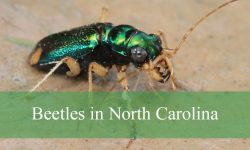
Doves are beautiful and their call is peaceful.
yes, that right!
We have a dove that has taken over a Robin’s old nest and has been sitting there for a few months alone. Seems strange to us, isn’t it the wrong time of year? September?